Guide to Foam Rolling
Foam rolling is a soft tissue therapy technique that can help improve an individual’s mobility in regards to flexibility and joint Range of Motion. Plus, foam rolling can also be used as a Regeneration tool to help an individual recover on a cellular level by means of assisting blood circulation that can deliver more nutrients to worked tissues as well as help extract metabolic waste from previous training sessions and exercise.
This article will cover:
• How Foam Rolling helps improve Mobility
• How to use various Foam Rolling Techniques
• Provides examples of Breathing exercises to help facilitate both Mobility and Regeneration
• An illustrated list of Foam Rolling exercises
Foam Rolling for Mobility
To make any improvement in Movement Quality or restore Biomechanical Integrity, an individual’s Mobility needs to be addressed and appropriately developed.
Define Mobility
A Google search for ‘mobility’ reveals a host of YouTube videos and Instagram posts of elaborate, if not exotic-looking, exercises not to mention the thousands of images of tactical military vehicles or motorized wheel-chairs and accessories. But in regard to Human Movement, Mobility refers to an individual’s capacity to move through a predetermined pattern of consecutive shapes or positions with complete accuracy and a full Range of Motion.An easy way to address Mobility is to ask, ‘Can the individual get into the correct position without some degree of compensation?’
Mobility is the combined product of an individual’s flexibility, joint health, and Motor Behavior (neuromuscular coordination). Together, these three attributes determine whether or not an individual can ‘get into the correct position.’
Flexibility
Almost everyone knows that muscles contract and lengthen. It is widely understood that all Human Movement is created by the elaborate process of multiple muscles contracting and lengthening in a coordinated fashion, much like an orchestra beautifully playing a symphony together. However, muscles are not the only physiological structures that contract and lengthen.
All four soft tissue structures—muscles, tendons, fascia and ligaments—have the ability to contract and lengthen, some more than others. Flexibility relates to the soft tissue’s ability as a whole to contract and lengthen.
Within the scope of the soft tissue, the Muscles, Tendons and Fascia are the three structures that contract and lengthen the most. Ligaments have a limited capacity to lengthen and when they are forced to lengthen, it is usually as a protective measure and a way to avoid immediate trauma, but may result in injury. On the other hand, muscles, tendons and fascia (an interwoven net of connective tissue spans throughout the entire body) expand and contract with great strength, speed, and accuracy. However, their maximum performance is reached only when all conditions are set appropriately for these tissues, which is one of the reasons why practicing Mobility exercises is so important.
Joint Health
What is a healthy joint? A joint that functions the way that it was designed to function. ‘Joint Health’ refers to the level of functionality of a joint, or arthrokinematics. Arthrokinematics is a term that describes the structural design and operational prescripts of a joint. More specifically, it is the study of how joint surfaces interact with one another to produce movement. Arthrokinematics is primarily where the qualities and measurements for Biomechanical Integrity are established.
Good ‘Joint Health’ means that the arthrokinematics are functioning as designed and that there is a high level of Biomechanical Integrity. However, good Joint Health is not always the case.
Many individuals experience obstructions caused by acute trauma, major and minor, as well as long time repetitive stresses that limit or impair the arthrokinematics of joints resulting in a malalignment in the joint and a pattern of compensation in Human Movement. For this reason, the habitual practice of Mobility exercises is recommended and highly encouraged.
Motor Behavior
Human Movement is a product of the neuromuscular system, which is the integration of the neurological and physiological systems. It is the combined efforts of the Nervous System and the soft tissue, i.e. muscles, tendons, fascia and ligaments that manipulate (move) the Skeletal System (bones) to actually create Human Movement.
Motor Behavior refers to the process of how Human Movement is ‘learned’ and developed over time through initiation, practice and repetition by the neuromuscular system. More specifically, it is the conceptual understanding of how the Nervous System coordinates and stimulates the soft tissue, particularly muscles, tendons, and fascia, to create movement.
The idea of Motor Behavior is a conceptual umbrella that includes Motor Learning (the way the Nervous System interprets and learns movement) and Motor Control (neuromuscular coordination, or the detailed way that the Nervous System communicates with soft tissue structures to ‘activate’ specific muscle fibers and initiate a contraction or lengthening sequence to create movement).
Motor Behavior, more specifically Motor Control (neuromuscular coordination) and Motor Learning, plays an important role in an individual’s Mobility because often a limitation or lack of mobility occurs due to the individual’s inability to use the Nervous System appropriately to create a specific movement or hold a particular position. More precisely, an individual may not have the appropriate Motor Control to perform a movement and must go through the process of Motor Learning to achieve success in that movement.
Any and all changes in both flexibility and joint health also affect the Motor Behavior of the individual – for better or for worse.
Mobility Changes
As previously mentioned, mobility is dependent on the individual’s flexibility, joint health (arthrokinematics), and Motor Behavior (neuromuscular coordination), all of which is changing on a daily basis – sometimes for the better and sometimes for the worse.
For the Worse
Repetitive movements and inactivity can put a strangle hold on an individual’s mobility as well as ability to recover, leading to high levels of stress and injuries. It’s important for the trainer, coach, and athlete to understand what can negatively impact mobility so that they can safeguard against these causes and plan appropriate countermeasures (PreHab and Corrective exercises) to affect the limitations on mobility.
Mobility Worsens with:
• Repetitive Movements – such as sitting or texting
• Inactivity – Sedentary and Actively Sedentary Lifestyles
• Lack of Recovery – Ineffective Work-to-Recovery Ratio in Training/Life
• Continual High Levels of Stress – Overactive Sympathetic Nervous System
• Injuries – Formation of Adhesions and Scar Tissue
Room for Improvement
Just as an individual’s level of mobility can worsen, it can also improve. There are a few different ways a person can change his mobility for the better, including soft tissue therapy, joint distraction exercises, and various forms of stretching.
The Importance of Mobility
Why is Mobility important? There are numerous answers that depend on the individual as well as his or her point in life and the particular activity he or she is trying to accomplish.
Mobility in Life
Every movement in life has a geometric shape constructed by the cooperation of the neurological and physiological systems, constituting human biomechanics. These geometric shapes are known as Movement Patterns. In order to perform a particular movement, the body needs to be able to create the appropriate shapes. If the body cannot create the necessary shapes, then the body cannot perform that movement.
Unfortunately, Human Movement is not held hostage by a lack of mobility. People still complete movements and tasks even when their mobility is not at the level it should be. However, a lack of mobility lessens the mechanical efficiency and quality of movement. Human Beings are very resilient and subconsciously ‘compensate’ as much as possible to complete a given movement.
Compensate to Achieve
All Human Movement is ‘task orientated’, and people move to accomplish specific goals or just to ‘get things done.’ More specifically, every movement a person makes is done to fulfill a particular goal. Whether the movement is just reaching up to scratch a nose, pulling open a door, or shifting nervously from side-to-side in a conversation, every movement made by a Human Being serves to complete a given task.
Without adequate Mobility, people will alter the way they perform a given movement to complete the task associated with the given movement. This is called “compensating” and it is a consequence of moving without adequate Mobility.
Example – an individual with limited mobility in his hips will round his spine forward into deep forward flexion to lift items off the floor despite the items’ weight. This altered form of movement, i.e. pattern of compensation, can and will create additional negative consequences in regards the individual’s biomechanics and level of Movement Quality.
A lack of mobility creates a pattern of compensation in an individual’s movement, which alters, if not, deteriorates the integrity (proper functionality) of that individual’s joints and corresponding tissues. The ultimate result of a lack of mobility is a lessening of Movement Quality that will create inefficiency in performance and eventually lead to injury over a long enough period of time.
Compensation Defined
The act of altering the naturally prescribed neuromuscular coordination and arthrokinematics (joint function) within an individual’s Movement Pattern is a form of compensation in regards to Human Movement.
Consequences of Compensation
Unfortunately, there are consequences for every act of compensation. Whether the degree of compensation was small and barely noticeable or large and obvious, an act of compensation will place an inappropriate amount of stress, in this case, misdirected kinetic energy, onto physiological structures, i.e. soft tissue cells and joints that were not designed to handle that amount of stress.
The exposure of these physiological structures to an inappropriate amount of stress jeopardizes and/or immediately compromises that individual’s biomechanical integrity and lowers his or her Movement Quality.
Compensation Grows
To make matters worse, compensation in Human Movement has the innate ability to escalate and express itself in prolonged and repeated acts of dysfunction that steadily increase the risk of physiological ‘break-down’ and injury.
Additionally, the repeated use of compensation patterns in movement changes an individual’s neurological approach to Human Movement. In other words, the more an individual executes a given movement pattern, such as squatting, with a form of compensation, the more the individual’s Nervous System learns and adapts so the compensation becomes the default neurological pattern to use in movement.
Exercising Makes Compensation Worse
It’s important to understand that compensation negatively impacts biomechanical integrity and Movement Quality. It’s also important to understand that exercising while various forms of compensation are present only decreases the level of biomechanical integrity and Movement Quality, unless the individual is practicing Corrective Exercises that intentionally target the corresponding movement dysfunctions.
Exercising Awareness
Exercising is one of the rare opportunities an individual has in his day to be consciously aware of how his body is moving. Most movements an individual makes through the course of the day are executed subconsciously, or more precisely, in a collection of ‘Movement Habits.’
Human beings utilize the ‘habit loop’ to coordinate and execute movements as a way to economize thought and provide more mental or conscious awareness on completing the task associated with that movement. However, exercising provides the opportunity for an individual to monitor as well as change his or her movement.
Placing ‘awareness’ on movement while exercising is an excellent way for an individual to assess, address, and eliminate patterns of compensation.
Reason to Stop
Once a pattern of compensation is recognized in how a person moves during exercise, there is an opportunity to interrupt that ‘movement habit’ and make an adjustment in the approach to movement, thus attempting to change the habit-like form of that compensation.
Interrupting Patterns of Compensation
1) Recognize the Compensation Strategy in the Movement Pattern
2) Cue and Coordinate Alternative Strategy Before Next Rep
3) Evaluate the Change in Movement
If an individual cannot change the execution of a Movement Pattern with three reps of cueing during exercise, then alternative techniques need to be applied to interrupt the pattern of compensation. This might include practicing Mobility exercises to increase Range of Motion of Flexibility.
Reason to Improve
Many times, Mobility exercise provides the missing flexibility and/or Range of Motion that allows an individual to execute a specific Movement Pattern with appropriate biomechanical integrity and optimal Movement Quality. Improvement in an individual’s Mobility also improves an individual’s functionality in Human Movement as well as increases the Quality of Life.
Improved Mobility also results in a positive effect within the realm of athletics, training, and personal fitness/health programs.
Form Equals Function
As mentioned before, Human Movement is formulated on geometrical shapes of the body. In other words, form equals function when it comes to Human Movement. The degree of an individual’s Mobility dictates her ability to function when it comes to sports, exercising, and more.
Practicing Mobility exercises provides the individual with the ability to get into the position that offers the highest level of function for a given task.
Mobility Offers Mechanical Advantage
When an individual is able to get into more positions, he or she can then utilize a position that offers a higher Mechanical Advantage, a useful skill in both sports and exercise.
Mechanical Advantage is taught and trained for in every sport, from Martial Arts to Gymnastics, from Baseball and American Football to Running.
Mechanical Advantage Improves Movement Quality
Having the Mobility to create a better level of Mechanical Advantage also benefits an individual’s Daily Life Activities. Mechanical Advantage allows an individual to reduce the stress on physiological structures while also limiting the risk of malalignments in the functioning of the joint (arthrokinematics). More importantly, having enough Mobility to create a Mechanically Advantageous position limits Compensation and Dysfunction.
The level of an individual’s Movement Quality is inversely related to the degree to which the individual moves with patterns of compensation or biomechanical dysfunctions in his or her Movement Patterns.
Ways to Increase Mobility
One of the most effective practices to use to increase one’s own level of Mobility and Movement Quality is Soft Tissue Therapy. However, before starting Soft Tissue Therapy, it’s a good idea to know some of the most common limitations and dysfunctions in Human Movement.
CLICK HERE to learn about Common Compensation Patterns and Movement Dysfunctions
Practicing Soft Tissue Therapy with Foam Rolling
Before foam rolling, first learn the most effective ways of practicing soft tissue therapy. Here are some effective soft tissue therapy techniques:
Foam Rolling & Soft Tissue Therapy Techniques
Hold and Release
Articulate the Joint
Slow Roll
Quick Roll
Oscillating
Rotating
Hold and Release
In this technique, an individual uses a soft tissue therapy tool, such as a foam roller or massage ball, to place pressure on a particular area of tissue where a knot of Myofascial Trigger Point exists. This procedure is very similar to both Swedish Massage and Acupressure techniques. The method utilizes pressure to stimulate mechanoreceptors within the soft tissue that send signals to the corresponding Motor Neurons so they release the Trigger Point or Knot.
Hold pressure over targeted area for 5-30 seconds or until the corresponding Trigger Point releases.
Articulate the Joint
In this technique, the individual places pressure over a sensitive area just as in the Hold and Release technique. Then the individual slowly articulates the corresponding joint. Articulate refers to moving the joint, i.e. flexing and extending or rotating the individual joint. For example, when the individual holds pressure on the calf muscles, the next step is to flex and extend or rotate the ankle. Movement at the joint causes the targeted tissue to lengthen and contract under pressure, which breaks up Trigger Points and clears out/separates adhesions in the area.
Hold pressure over a targeted area and articulate the joint for 5-30 seconds or until the sensitivity in the tissue dissipates.
Slow Roll
In this technique, the individual slowly rolls over a sensitive area in an attempt to drain blood from the tissue and pull out metabolic waste that may be contributing to the formation of a Trigger Point. At the same time, the Slow Roll improves circulation in the area; the increased blood flow adds more oxygen and nutrients to the affected area, all of which facilitates the release of Trigger Points and lengthens the tissue.
Perform several Slow Rolls in a smooth and deliberate fashion over the affected area for approximately 30 seconds or until the Trigger Point releases.
Quick Roll
In this technique, the individual practices several smooth and quick rolls of pressure over a targeted area in an attempt to stimulate the proprioceptors and mechanoceptors within the tissue to increase neuromuscular activity in the area, consequently improving blood flow and flexibility. However, Quick Rolls are often ineffective in regard to releasing Trigger Points or breaking up adhesions. This technique is very effective in increasing blood flow and stimulating the tissue. It is recommended to be used as a complimentary technique to the Slow Roll.
Perform numerous Quick Rolls over a targeted area in a smooth and deliberate fashion for 15-30 seconds.
Oscillating
Oscillating is a method similar to and can be combined with the Slow Roll and Quick Roll. In this technique, the individual practices several smooth rolls over a targeted area and then intermittently pauses and oscillates (rotate) the roll from side to side at different positions. This oscillation effect redirects pressure across the cells of the soft tissue in a massage technique called Cross-Fibering. Cross-Fibering uses pressure to widen and separate soft tissue cells. This extracts metabolic waste from the cells and increases blood flow and oxygen to the cells that release Trigger Points. Additionally, the lateral direction of the oscillation force has the potential of dislodging fibrin and collagen fibers that make up adhesions in the soft tissue.
Perform numerous Oscillations while rolling over a targeted area for approximately 30 seconds.
Rotating
This technique is very similar to Oscillating except with a change in direction. In this practice, the individual applies pressure in a twisting fashion to a targeted area. More specifically, the individual rotates an object, such as a ball or a knuckle, while also pressing the object into the tissue. The results are the same as oscillating: improved blood flow to the affected area, removal of metabolic waste, and even dislodgement of possible adhesions.
Perform numerous Rotations while applying pressure to a targeted area for approximately 30 seconds.
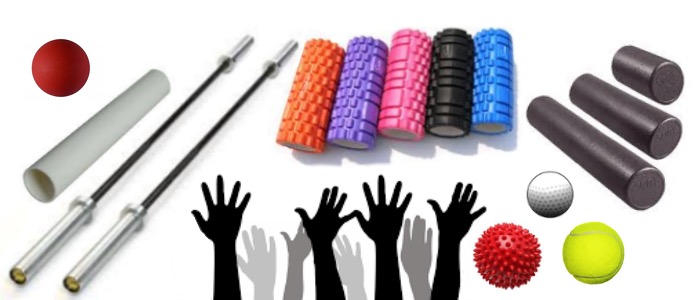
Soft Tissue Therapy Tools
The next step is to understand the characteristics of the different tools used in soft tissue therapy: foam rollers, lacrosse balls, softballs, golf balls, specialized massage balls, rolling sticks, barbells, PVC plastic tubing, and much more.
Density Matters
Each of the aforementioned soft tissue therapy tools has a different density, which results different types and/or levels of pressure applied to the body using that particular tool. Simply put, the density dictates the amount of pressure. The harder the object, the greater the magnitude of pressure available for the soft tissue therapy technique.
The magnitude of pressure majorly impacts the physiological reaction in the tissue. The more the pressure increases in magnitude, the larger the sensation emitted through the soft tissue.
The magnitude of pressure in soft tissue therapy is similar to the volume of one’s voice in a large auditorium. The louder the voice, the more the sound is heard echoing in the auditorium. That being said, a very well-trained voice can make a whisper heard throughout the entire auditorium.
Sensitivity
As noted above, louder and harder are not always better. This is especially true in soft tissue therapy as each person has a different tolerance level for pain and discomfort. While a greater magnitude of pressure creates a physiological reaction in more tissue, all that gain can be lost if the individual cannot tolerate that level of pressure. Many people tense their soft tissue as protection against a pressure that exceeds their sensitivity threshold. Therefore, it is more effective to use a soft tissue therapy tool that creates a tolerable magnitude of pressure for the individual.
Use a soft tissue therapy tool dense enough to elicit a physiological change in the soft tissue without creating unnecessary tension in the tissue from exceeding the individual’s sensitivity threshold.
List of Soft Tissue Therapy Tools According to Density:
Foam Roller (Styrofoam)
Tennis Ball
Massage Ball
Foam Roller (Padded PVC Tube)
Rolling Stick
Lacrosse Ball/Softball
Golf Ball
PVC Plastic Tubing
Barbell
Human Hands (Self-Massage)
Note, the firmness and pressure produced by each soft tissue therapy tool can be modified and regulated by the way in which the tool is used.
Remember to Breathe
It is extremely important to breathe with an emphasis on large exhalations when practicing soft tissue therapy. This stimulates the Parasympathetic Nervous System and causes more beneficial changes in the soft tissue.
Breathing
Human Beings can go:
Weeks without food.
Days without water.
Only minutes without breathing.
These truths put into perspective the importance of breathing for survival. However, survival is not the only thing to which breathing is critical; breathing is essential to Mobility Training. An individual can only ‘go’ as far as his breathing takes him. To understand the relationship between breathing and mobility, we start with a simplified description of the Nervous System.
Nervous System: A Tale of Two Tones
The Nervous System in the Human Body is said to have two ‘subsystems’ that influence physiological and biochemical reactions in the body.
The Nervous System is divided into:
The Sympathetic Nervous System
The Parasympathetic Nervous System
The general functions of these two subsystems can be characterized in similar fashion to the gas pedal and brake of a car.
The Sympathetic System (SNS) is the gas pedal.
The Parasympathetic System (PNS) is the brake pedal.
Sympathetic System: Fight or Flight
The Sympathetic Nervous System (SNS) gets a person to get up and go, especially in ‘fight or flight’ situations, by creating tension in the body that prepares the neuromuscular system to create fast, explosive movements, i.e. Fight or flight. The SNS also releases specific stress hormones, including adrenaline and cortisol, to provide an adequate amount of energy to sustain the necessary movements of fight or flight.
In general, the SNS acts as a ‘gas pedal’ that creates a specific environment in the body characterized by tension and stress hormones.
Parasympathetic System: Rest and Digest
On the other hand, the Parasympathetic Nervous System (PNS) acts as a brake for the ‘go-go-go’ of the Sympathetic Nervous System (SNS) and its ‘fight-or-flight’ responses. The PNS is characterized as the ‘rest and recover’ system because the chain of biochemical and physiological reactions that occur enables the body to engage in protein synthesis, cellular regeneration, and the deflation of stores of tension in the neuromuscular structures (muscles, tendons and fascia). More specifically, the PNS transmits neurological signals to command the motor units of locked muscle fibers (myofascial trigger points, aka knots) to release and lengthen again.
The PNS also assists in re-oxygenating the blood supply. When combined with improved circulation through the soft tissue due to the absence of neuromuscular tension, this can rectify the pH levels of the cells and accelerate cellular regeneration. In summary, the PNS helps the soft tissue release, recover, and regenerate.
Regulating the Two Systems
Long before science ever named and categorized the Sympathetic Nervous System (SNS) and the Parasympathetic Nervous System (PNS), Human Beings created specific ways to manage and regulate these two systems. Many of these ‘practices,’ including yoga and Tia Chi, are based on both breathing and movement. Or, more precisely, these practices were based on a specialized movement for breathing.
An individual can stimulate and/or regulate both the Sympathetic Nervous System (SNS) and the Parasympathetic Nervous System (PNS) with the use of specified breathing techniques.
Inhale vs Exhale
Each portion of the breathing cycle, the inhale and the exhale, has a differing effect on the Nervous System in terms of the subsystem stimulated and prompted to action.
Inhale > SNS
The Sympathetic Nervous System (SNS) is stimulated or activated when an individual inhales deeply, holds her breath or maintains a 1:1 breathing ratio of inhalation to exhalation.
This means that when an individual breathes in deeply or holds her breath, her Nervous System cultivates a more Sympathetic ‘Tone.’ This meaning there is an increase in biochemical and physiological reactions in the body that correlate to the ‘fight or flight’ response, pumping the individual with adrenaline.
Example – Many people ‘take a deep breath’ before heading into a performance, whether shooting a foul shot in basketball or giving a speech in front of peers and/or colleagues.
Exhale > PNS
Conversely, when an individual deeply exhales or consecutively breathes in an exhalation cycle longer than an inhalation (as is practiced in some breathing meditations), that person’s Nervous System develops a Parasympathetic ‘tone’, which increases specific biochemical and physiological reactions correlating to ‘rest and recover’.
The release of bound or locked Actin and Myosin within a muscle fiber translates to the length of a given muscle and is one of the physiological responses or benefits associated with a Parasympathetic ‘tone’ of the Nervous System.
Essentially, the more the exhale is emphasized in breathing, the more active the PNS becomes, and the more release/lengthening occur in the soft tissue. This translates to a greater Range of Motion around the joints and improved overall Mobility.
An individual’s Mobility greatly benefits when the Nervous System has a Parasympathetic ‘Tone,’ which can be induced with a breathing practice that emphasizes the exhalation over the inhalation (or the act of holding the breath).
Exhale to Mobilize
The biochemical and physiological reactions associated with a Parasympathetic ‘Tone’ of the Nervous System are a great benefit to any individual’s Mobility practice, which is one of the reasons many yoga classes begin with a ‘Lion’s Breathe,’ or a large exhale.
Emphasizing the exhale while practicing the Mobility exercises in this book enhances the effectiveness of the exercises.
Practicing the Exhale
Breathing is a habit. More precisely, breathing is a neuromuscular skill, the same as juggling, shooting a jump shot in basketball, throwing a curve ball in baseball, or doing a cartwheel over a balance beam in gymnastics.
Individuals develop and constantly practice this ‘habit’ or specified Movement Pattern of breathing. Some individuals are ‘high chest’ breathers and others are ‘relaxed belly’ breathers. The method in which an individual breathes soon becomes a strong, well-developed movement habit or neuromuscular skill as an individual breathes approximately 1,200 in a given day. This equates to 1,200 repetitions of the same Movement Pattern!
12,000 repetitions on a daily basis strongly re-enforces an individual’s Movement Pattern or ‘habit’ of breathing – for better or for worse.
Developing a New Breathing Habit
Since breathing is a neuromuscular skill, aka movement habit, individuals who are “inefficient breathers” need to develop a new way of breathing to replace the inefficient way of breathing as it relates to Mobility. A positive and efficient habit of breathing leads to many benefits in the rest of the body’s Mobility Training.
Mobility Training receives positive re-enforcement from breathing habits that emphasize large or deep exhales as opposed to breathing habits that either emphasize the inhale or holding the breath.
Breathing Exercises
Here are two very simple breathing exercises an individual can use to develop a more effective breathing habit.
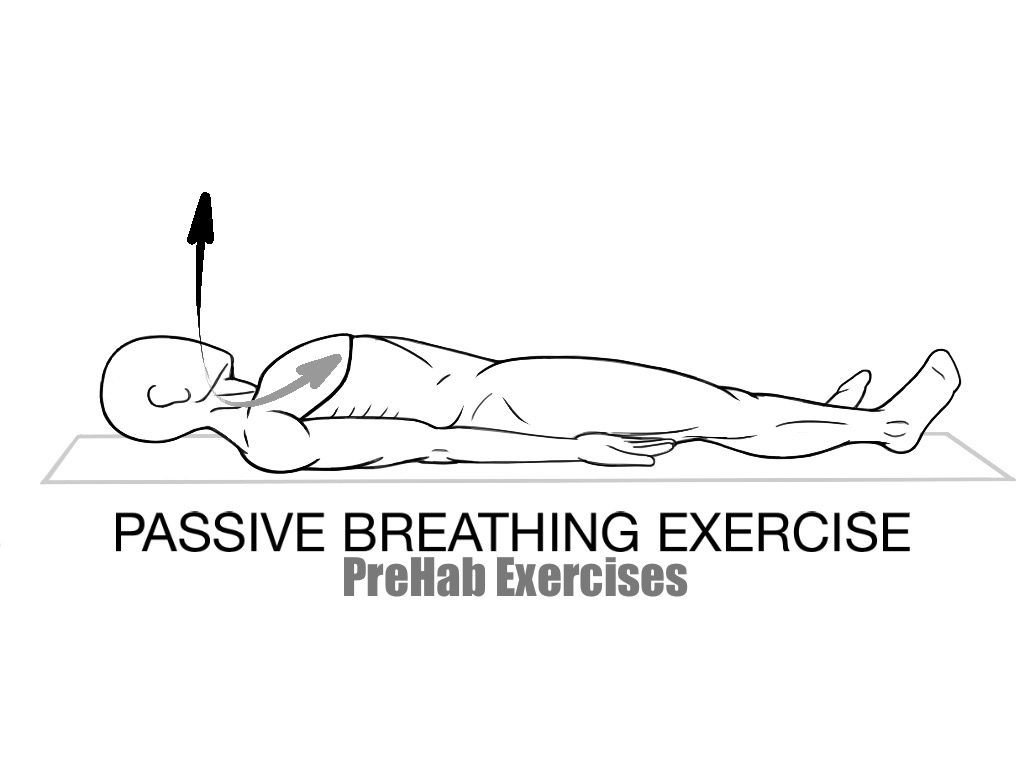
Passive Breathing Exercise
Lie on the floor with palms face-up alongside the body and feet positioned shoulder-width apart. Reach the crown of the head towards the horizon and the heels of the feet towards the other horizon to feel ‘tall’ or ‘long’ from head to toe. Relax the body as much as possible and close the eyes.
Next, allow the breath to enter and exit the body. Do not try to actively breathe. Instead, remain as passive as possible and just allow the breath to breathe itself.
Start to give the ‘weight of your body’ over to the floor on each and every exhale. In other words, feel the floor hold the ‘weight of the body’ more and more, which releases the neuromuscular tension stored in the soft tissue.
Continue to give the ‘weight of the body’ to the floor on each exhale for 60-90 seconds or a total of 30 breaths.
This exercise teaches the body to use each breath to release tension in the soft tissue, which assists in all Mobility Training.
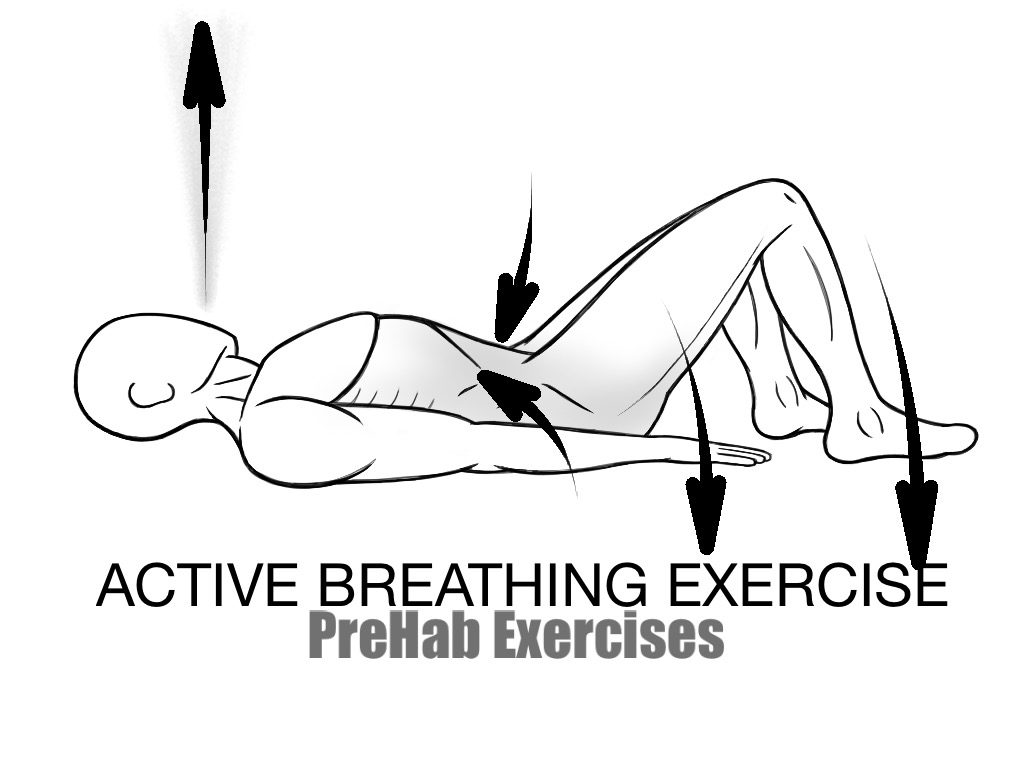
Active Breathing Exercise
Lie on the floor with the arms placed alongside the body with palms face-down and feet flat on the floor, positioned shoulder-width apart and knees bent at 90º angles.
Now, breathe and send the breath of each exhale all the way up to touch the ceiling, as if attempting to blow out birthday candles across the room. This action engages the Core Muscles when exhaling, which is beneficial to both Core Stability as well as activating the Parasympathetic Nervous System.
Practice 3-5 Cycles of Exhalations.
Next, pull the belly button and sides of the torso in towards the spine on each exhalation. This action engages the Transverse Abdominis and Oblique (Core) Muscles that drive a larger breathe out on each exhale, which assists in activating the Parasympathetic Nervous System.
Practice 3-5 Cycles of Exhalations.
Afterwards, press hands and feet into the floor still constantly engaging the Core muscles and attempting to ‘blow out birthday candles’ or touch the ceiling with the exhalation.
Pressing hands and feet into the floor while exhaling will engage Pelvic Floor Muscles, as well as the Glutes (Hips) Muscles, Latissimus Dorsi, and Rhomboids (Back) Muscles. The engagement of these muscles, in combination with the engagement of the Transverse Abdominis and Oblique (Core) Muscles, creates a synergy of forces in the body, in which five sides of the torso drive the breath out towards the ceiling to create the largest possible exhalation.
Practice 5-10 Cycles of Exhalations.
This Active Breathing Exercise teaches an individual the neuromuscular coordination necessary to develop adequate Core Stability, but more importantly, this exercise stimulates the Parasympathetic Nervous System, which helps the soft tissue relax, release, and lengthen to improve the individual’s overall level of Mobility.
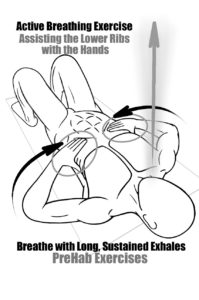
GUIDE TO FOAM ROLLING
Things to Know- Before getting started, it is important to understand how to effectively Foam Roll. Here are some recommended techniques for Foam Rolling:
Foam Rolling Techniques
Hold and Release
Articulate the Joint
Slow Roll
Quick Roll
Oscillating
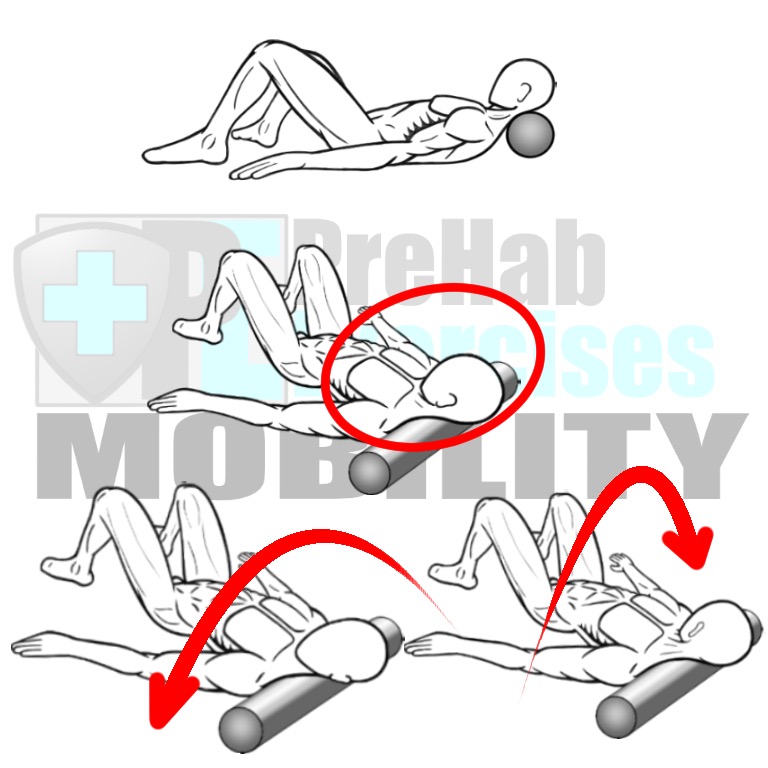
FOAM ROLLING THE SUBOCCIPITAL TRIANGLE WITH OSCILLATION
HEAD AND NECK
Benefits:
• Releases tension in neck from repetitive movements in driving, computer work, and texting.
• Helps to correct Forward Head Alignment and Upper Cross Syndrome.
• Assists to develop proper Spinal alignment and stability.
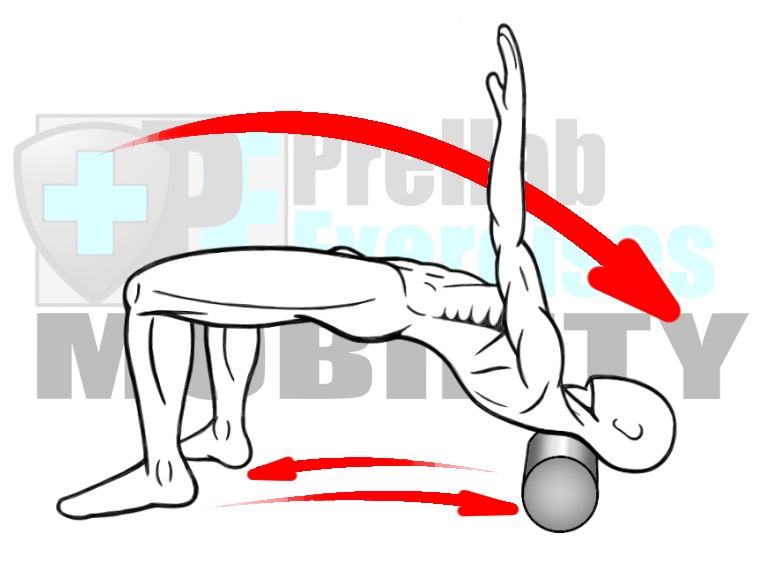
FOAM ROLLING THE UPPER TRAPEZIUS
NECK AND SHOULDERS
Benefits:
• Releases tension and Trigger Points in the neck and shoulders that build up from repetitive movements, such as driving, computer work, wearing a backpack or shoulder bag and texting.
• Also releases tension and Trigger Points caused by overhead and/or upper body exercises.
• Helps to correct Forward Head Alignment, Upper Cross Syndrome, and Shoulder Impingement or pain.
• Assists to develop appropriate Shoulder alignments and stability.
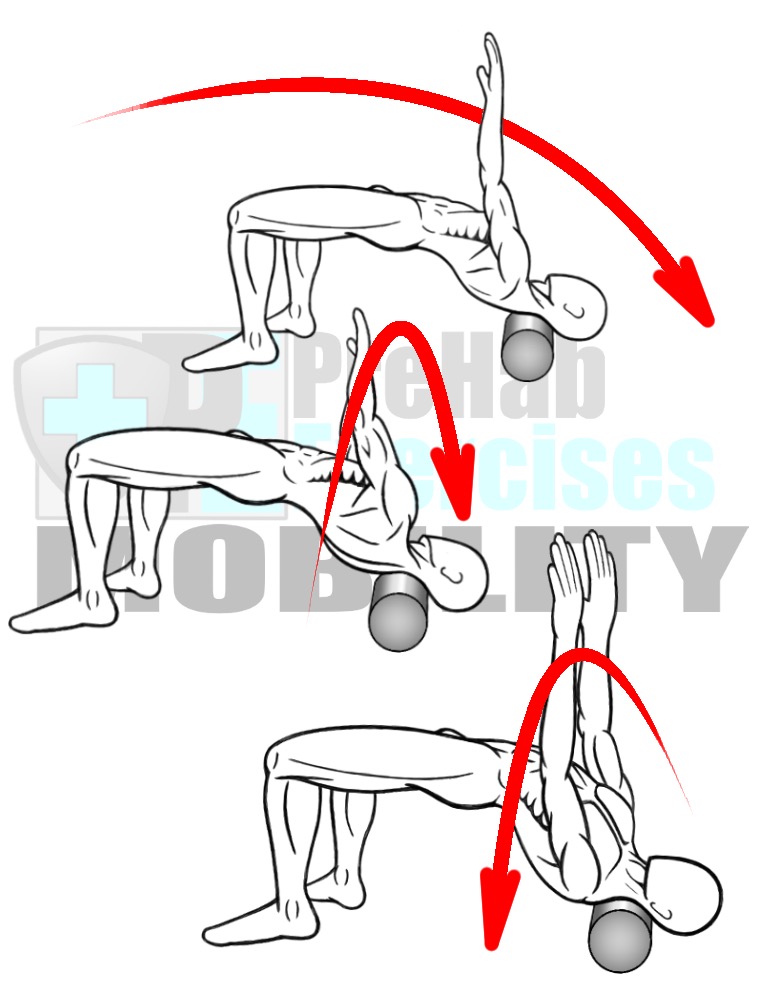
FOAM ROLLING THE UPPER TRAPEZIUS WITH OSCILLATION
NECK AND SHOULDERS
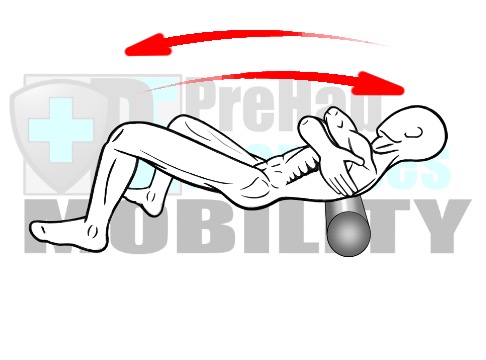
FOAM ROLLING THE RHOMBOIDS, LOWER AND MID-TRAPEZIUS
THORACIC SPINE AND BACK
Benefits:
• Increases the Range of Motion and Flexibility of the Thoracic Spine as well as the shoulders.
• Improve efficiency and Movement Quality in Overhead, Throwing, Pulling and Pressing movements.
• Helps to correct Forward Head Posture, Upper Cross Syndrome and Shoulder Impingements or pain.
• Promotes post-exercise soft tissue recovery and regeneration.
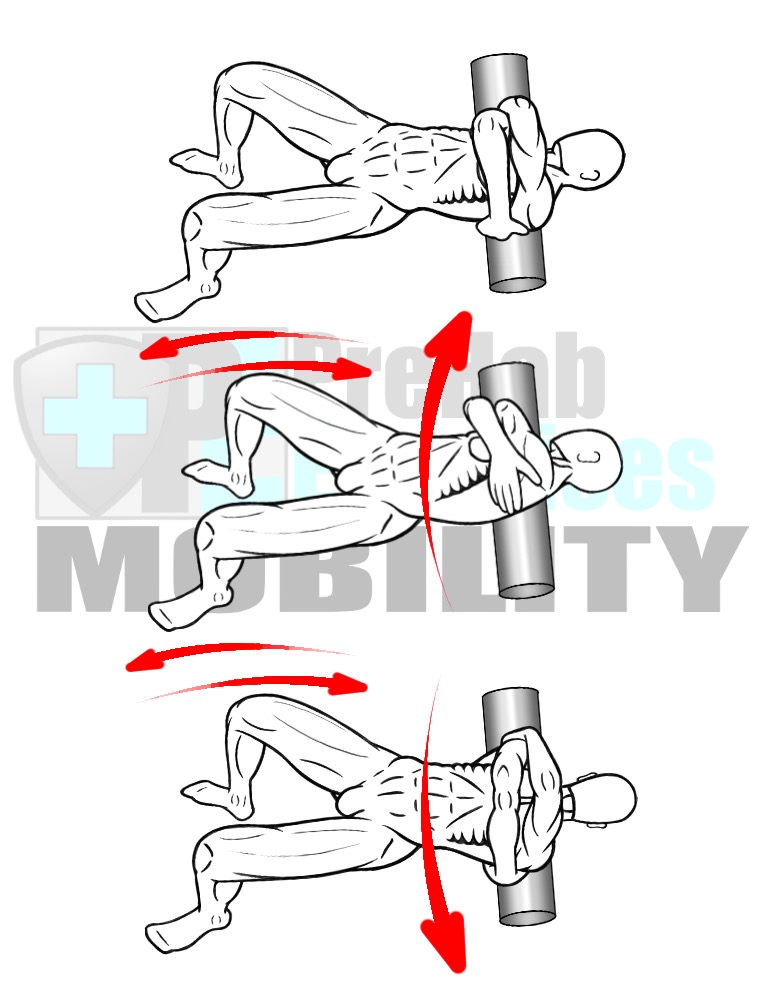
FOAM ROLLING THE RHOMBOIDS AND TRAPEZIUS WITH OSCILLATION
THORACIC SPINE AND BACK
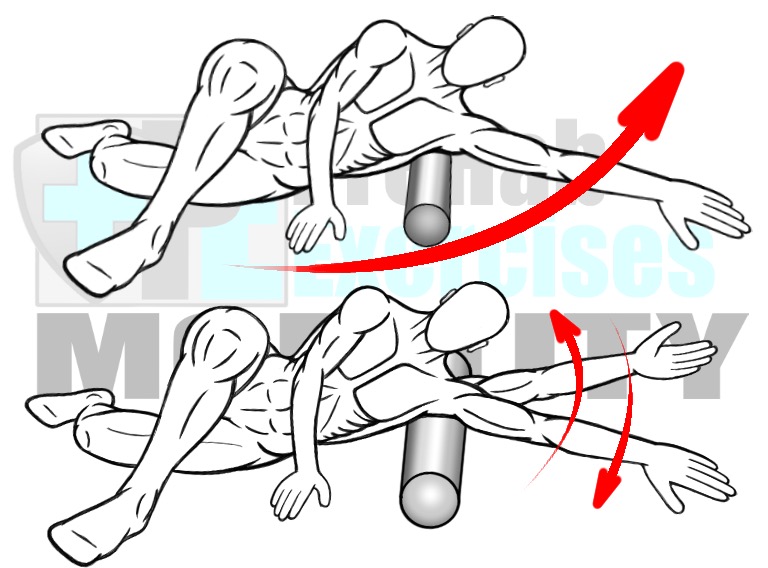
FOAM ROLLING THE LATISSIMUS DORSI AND TERES MAJOR
BACK AND SHOULDERS
Benefits:
• Increases the Range of Motion and Flexibility of the Shoulders as well as the Thoracic Spine.
• Improve efficiency and Movement Quality in Overhead, Throwing, Pulling and Pressing movements.
• Helps to correct Forward Head Posture, Upper Cross Syndrome and Shoulder Impingement or pain.
• Promotes post-exercise soft tissue recovery and regeneration.
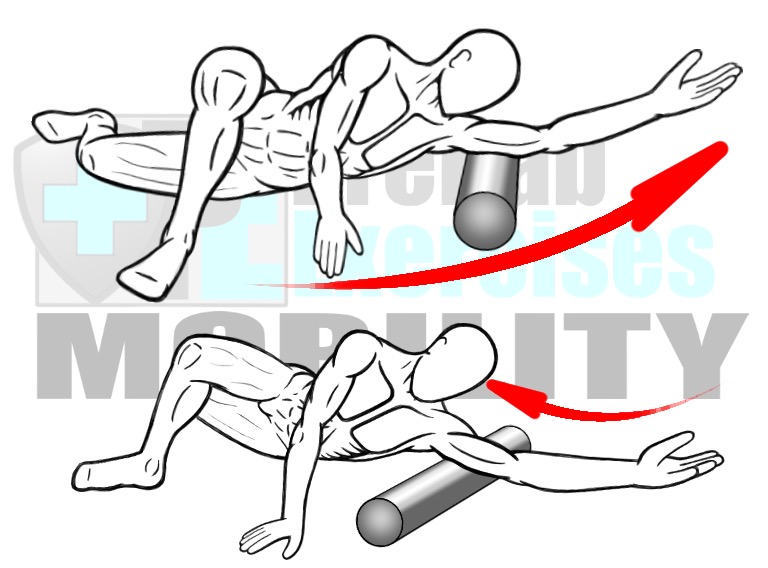
FOAM ROLLING THE TRICEPS
ARMS
Benefits:
• Increases the Range of Motion of the Elbow and Arm.
• Increases the neuromuscular responsiveness and the force production of the arm.
• Improves Movement Quality in Overhead, Throwing, Pulling and Pressing movements.
• Promotes post-exercise soft tissue recovery and regeneration.
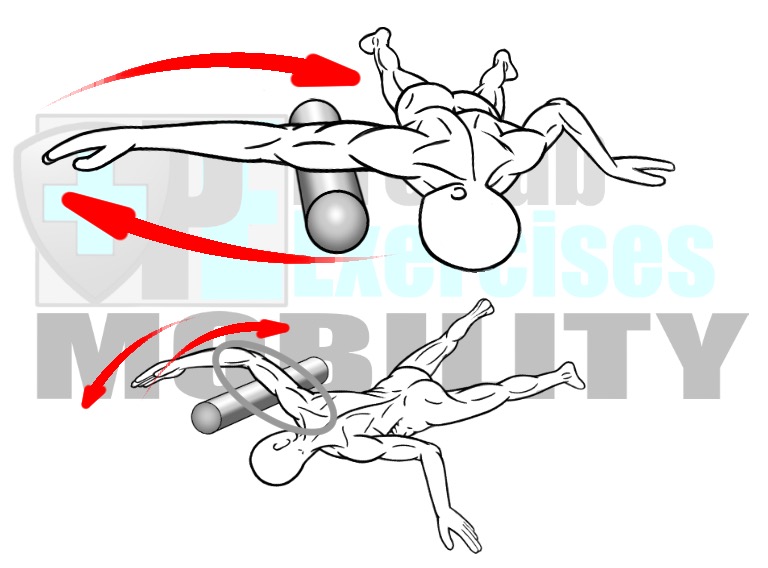
FOAM ROLLING THE BICEPS
ARMS
Benefits:
• Increases the Range of Motion of the Elbow and Arm.
• Increases the neuromuscular responsiveness and the force production of the arm.
• Improves Movement Quality in Overhead, Throwing, Pulling and Pressing movements.
• Helps correct Upper Cross Syndrome and rectifies static and dynamic posture.
• Promotes post-exercise soft tissue recovery and regeneration.
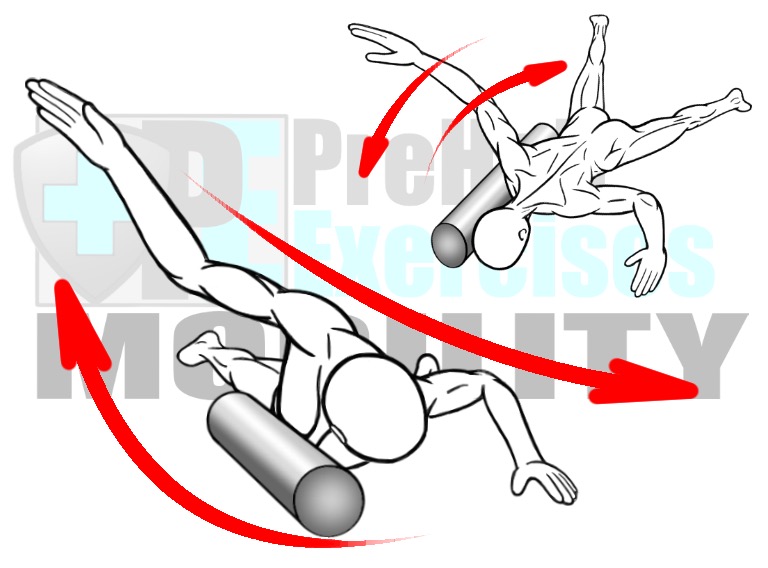
FOAM ROLLING THE PECTORALIS COMPLEX
CHEST AND SHOULDERS
Benefits:
• Increases the Range of Motion of the Thoracic Spine and Shoulders.
• Increases neuromuscular force production and responsiveness of the shoulders and arms.
• Improves Movement Quality in Overhead, Throwing, Pulling and Pressing movements.
• Helps to correct Upper Cross Syndrome and improves static and dynamic posture.
• Promotes post-exercise soft tissue recovery and regeneration.
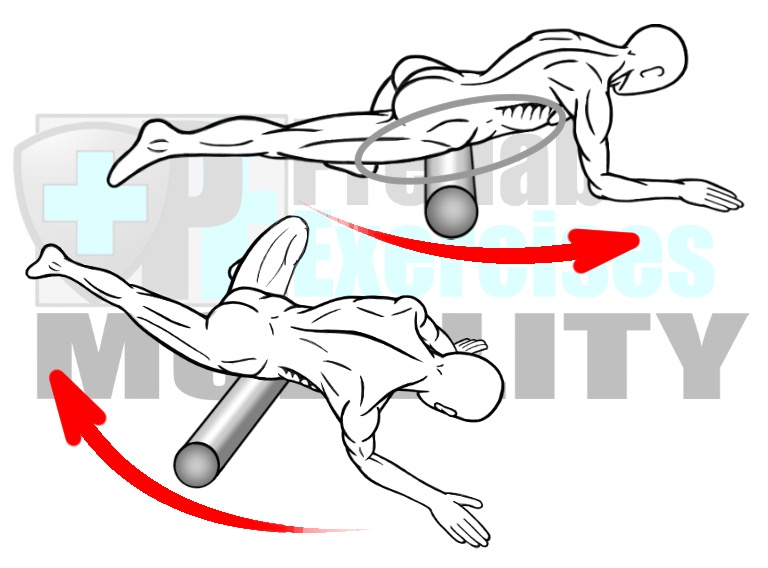
FOAM ROLLING THE TENSOR FASCIAE LATAE (TFL)
SUPERFICIAL HIP FLEXOR
Benefits:
• Increases the Range of Motion of Hip Extension, Triple Extension and Gait Cycle or stride length.
• Increases neuromuscular force production and responsiveness of the Hips and Lower Body. Improves Movement Quality in Squatting, Hinging, Lunging, Jumping and Running.
• Helps to correct Lower Cross Syndrome, Pronation Distortion Syndrome, Asymmetrical Weight-Shifts and improves static posture, including standing and dynamic alignment.
• Promotes post-exercise soft tissue recovery and regeneration.
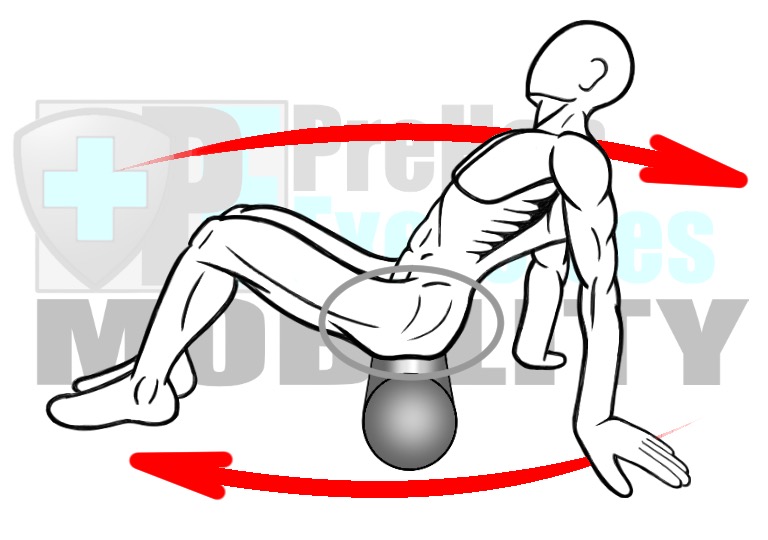
FOAM ROLLING THE GLUTEUS COMPLEX
POSTERIOR HIP
Benefits:
• Increases the Range of Motion of Hip Flexion, Internal/External Rotation and Adduction.
• Increases neuromuscular force production and responsiveness of the Hips and Lower Body. Improves Movement Quality in Squatting, Hinging, Lunging, Jumping and Running.
• Helps to correct Asymmetrical Weight-Shifts, Buttwinks, Sway Back, Glute Amnesia Syndrome and improves static posture and dynamic alignment.
• Foam Rolling promotes post-exercise soft tissue recovery, and regeneration.
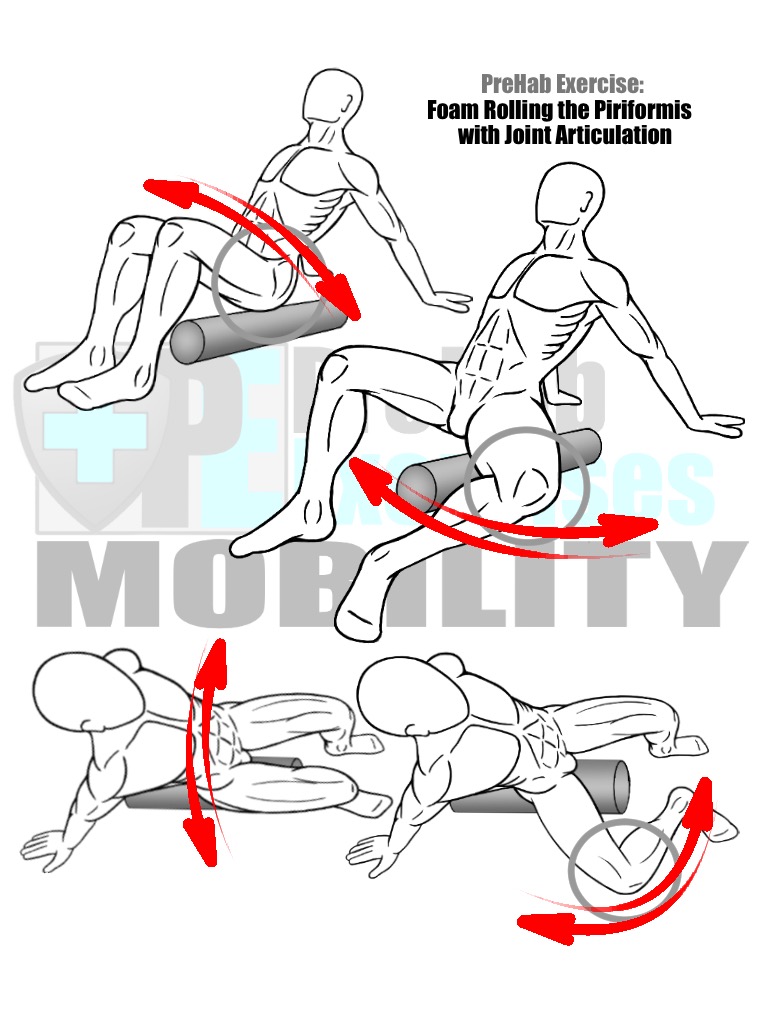
FOAM ROLLING THE GLUTEUS COMPLEX WITH JOINT ARTICULATION
ROTATION OF THE PELVIS – POSTERIOR AND LATERAL HIP
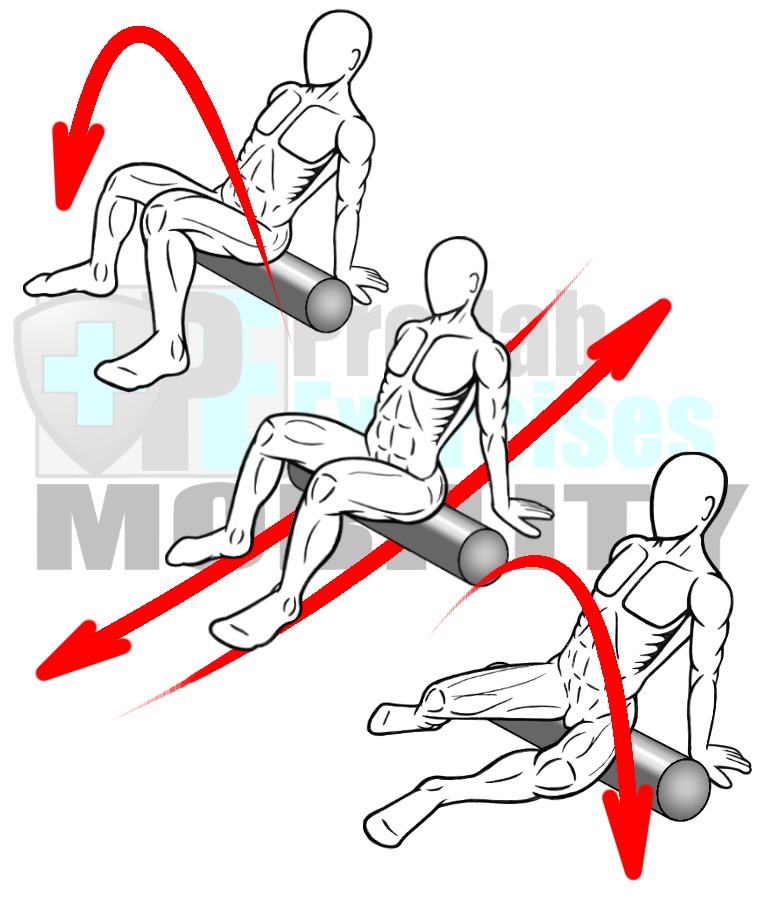
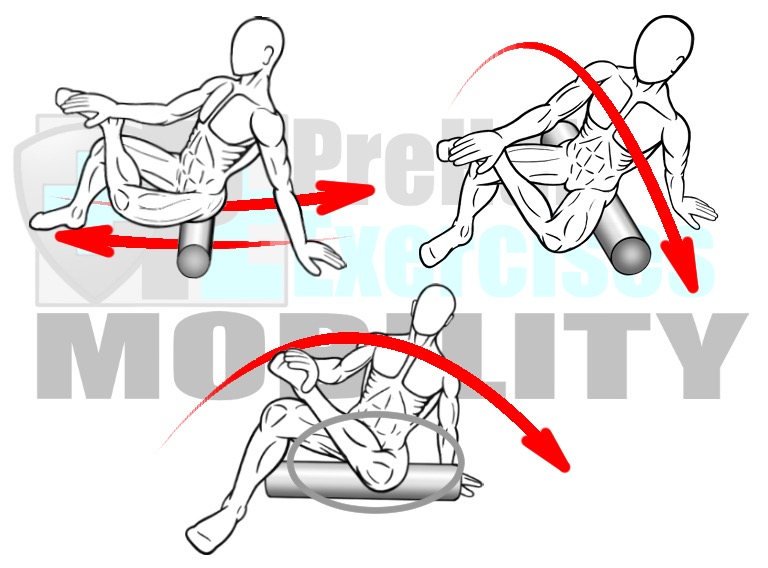
FOAM ROLLING THE GLUTEUS COMPLEX AND PIRIFORMIS
POSTERIOR AND LATERAL HIP
Benefits:
• Increases the Range of Motion of Hip Flexion, Internal/External Rotation and Adduction.
• Increases neuromuscular force production, coordination, balance responsiveness, and stability of the Hips and Lower Body. Improves Movement Quality in Squatting, Hinging, Lunging, Jumping and Running.
• Helps to correct Asymmetrical Weight-Shifts, Buttwinks, Sway Back, Glute Amnesia Syndrome and improves static posture and dynamic alignment.
• Foam rolling promotes post-exercise soft tissue recovery, and regeneration.
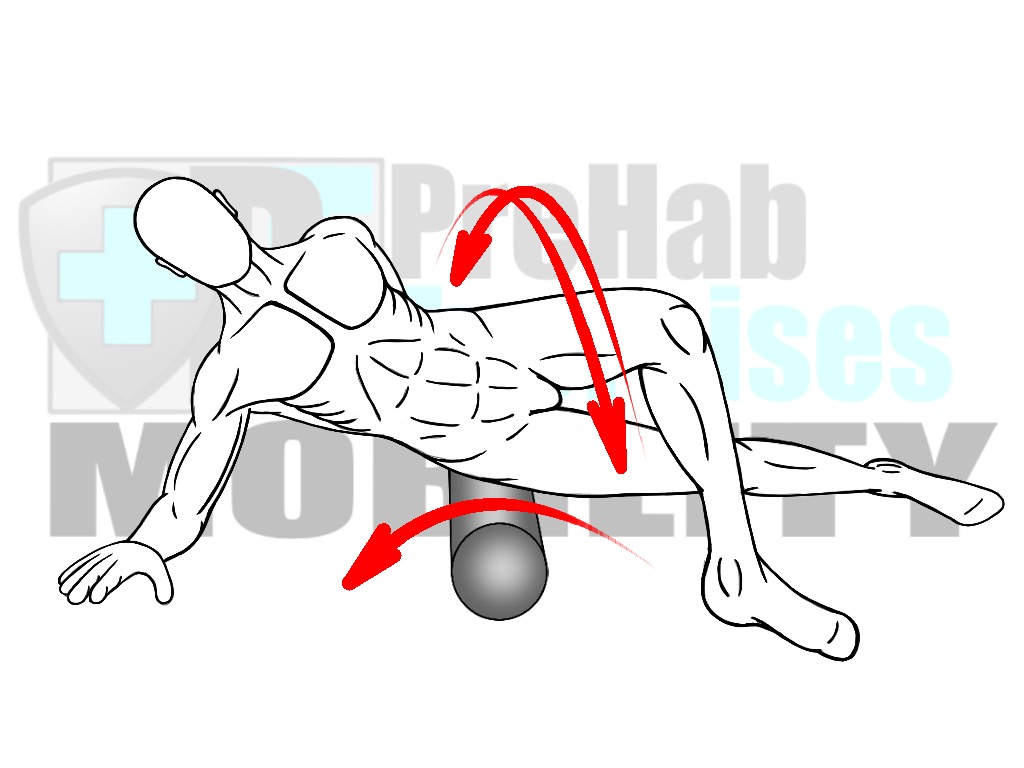
FOAM ROLLING THE GLUTEUS MEDIUS
LATERAL HIP
Benefits:
• Since the Gluteus Medius (Lateral Hip Muscle) grows inactive due to prolonged periods of sitting, this muscle can become overworked and spastic while training or competing due to the accumulation of Myofascial Trigger Points (Knots). It is beneficial to habitually roll the Gluteus Medius before training and competition as well as in Recovery and Regeneration sessions. Foam rolling the Gluteus Medius increases responsiveness and coordination of the Hip, which leads to improved force production and Stability in Single-Leg Positions and/or Movements. Helps to improve Movement Quality in Squatting, Hinging, Lunging, Jumping, Running and Standing.
• Helps to correct Valgus Knee, Pronation Distortion Syndrome, Low Back Pain, Asymmetrical Weight-Shifts and improves static posture and dynamic alignment.
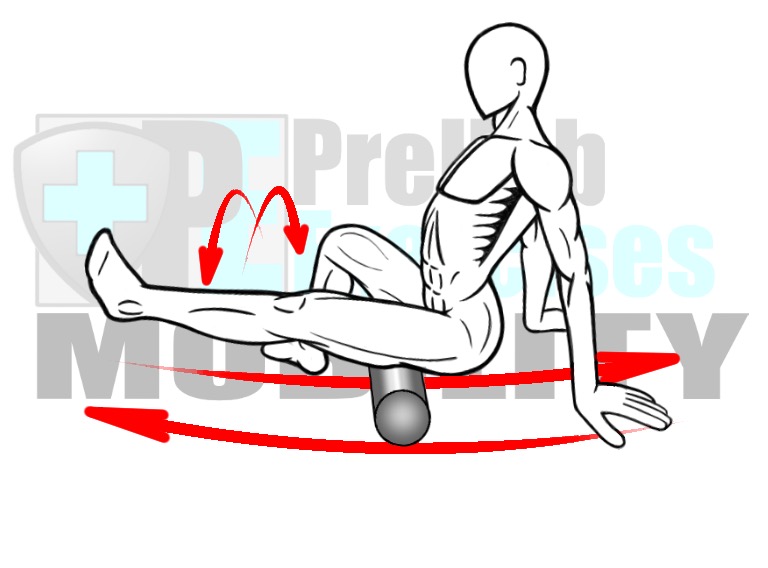
FOAM ROLLING THE HAMSTRING COMPLEX
POSTERIOR LEG
Benefits:
• Increases the Range of Motion of Posterior Chain, including Hip Flexion and Knee Extension.
• Increases neuromuscular force production, responsiveness and coordination of the Posterior Chain and Lower Body. Improves Movement Quality in Squatting, Hinging, Lunging, Jumping, Running and Standing.
• Helps to correct Hamstring Strains, Pronation Distortion Syndrome, Posterior Pelvic Tilt, Buttwinks Asymmetrical Weight-Shifts and improves static posture and dynamic alignment.
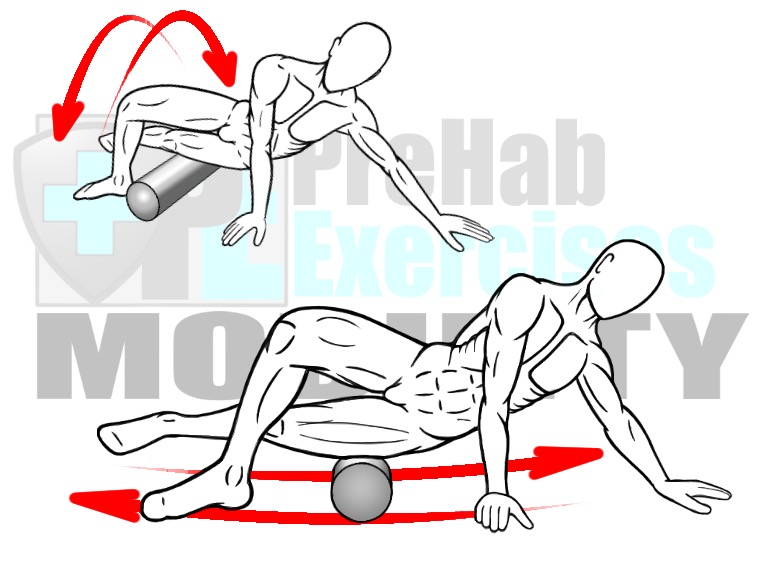
FOAM ROLLING THE VASTUS LATERALIS AND ILIOTIBIAL BAND
IT BAND AND LATERAL LEG
Benefits:
• Increases the Range of Motion of Hip Extension and Adduction.
• Increases neuromuscular force production, responsiveness, and coordination of the Lower Body. Improves Movement Quality in Squatting, Hinging, Lunging, Jumping, Running, and Standing.
• Helps to correct Patellofemoral Tracking Disorder (Knee Alignment), Pronation Distortion Syndrome, Asymmetrical Weight-Shifts, and improves static posture and dynamic alignment.
• Reduces Patellofemoral Pain Syndrome (Knee Pain) and IT Band Syndrome.
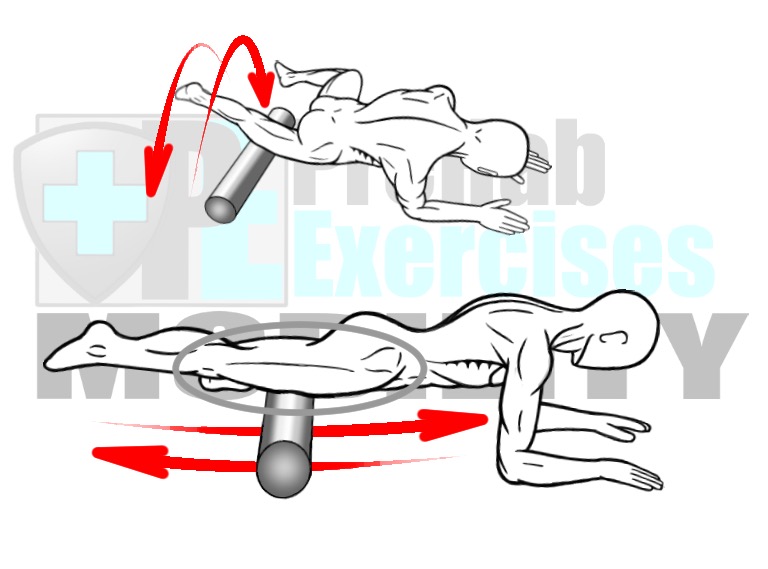
FOAM ROLLING THE QUADRICEPS
ANTERIOR LEG
Benefits:
• Increases the Range of Motion of Hip Extension and Knee Flexion.
• Improves force transfer and coordination around the Knee, which translates to increased Movement Quality in Squatting, Hinging, Lunging, Jumping, Running and Standing.
• Helps to correct Patellofemoral Tracking Disorder (Knee Alignment), Pronation Distortion Syndrome, Asymmetrical Weight-Shifts, Glute Amnesia Syndrome and improves static posture and dynamic alignment.
• Reduces Patellofemoral Pain Syndrome (Knee Pain).
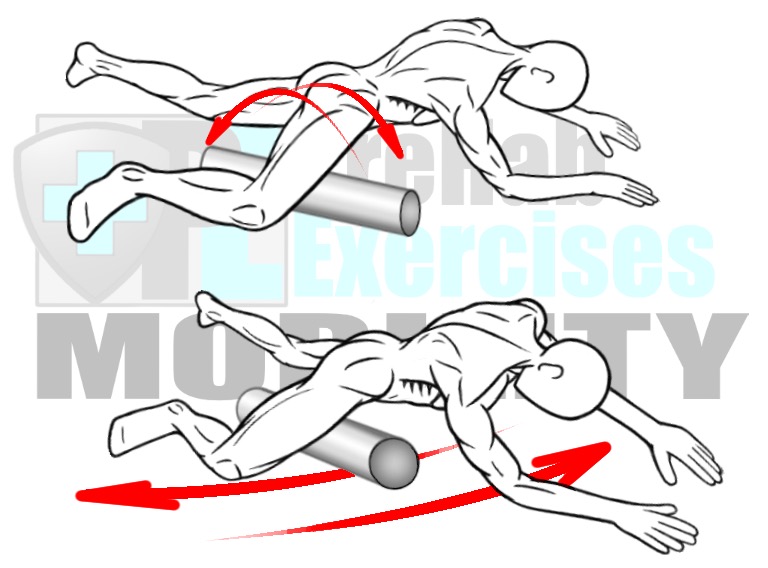
FOAM ROLLING THE ADDUCTORS
MEDIAL LEG AND GROIN
Benefits:
• Increases the Range of Motion of Hip Extension and Abduction.
• Improves force transfer and coordination between the Hip, Spine, and Knee, which translates to increased Movement Quality in Squatting, Hinging, Lunging, Jumping, Running and Standing.
• Helps to correct Pronation Distortion Syndrome, Buttwink, Glute Amnesia Syndrome, Sway Back, Asymmetrical Weight-Shifts, and improves static posture and dynamic alignment.
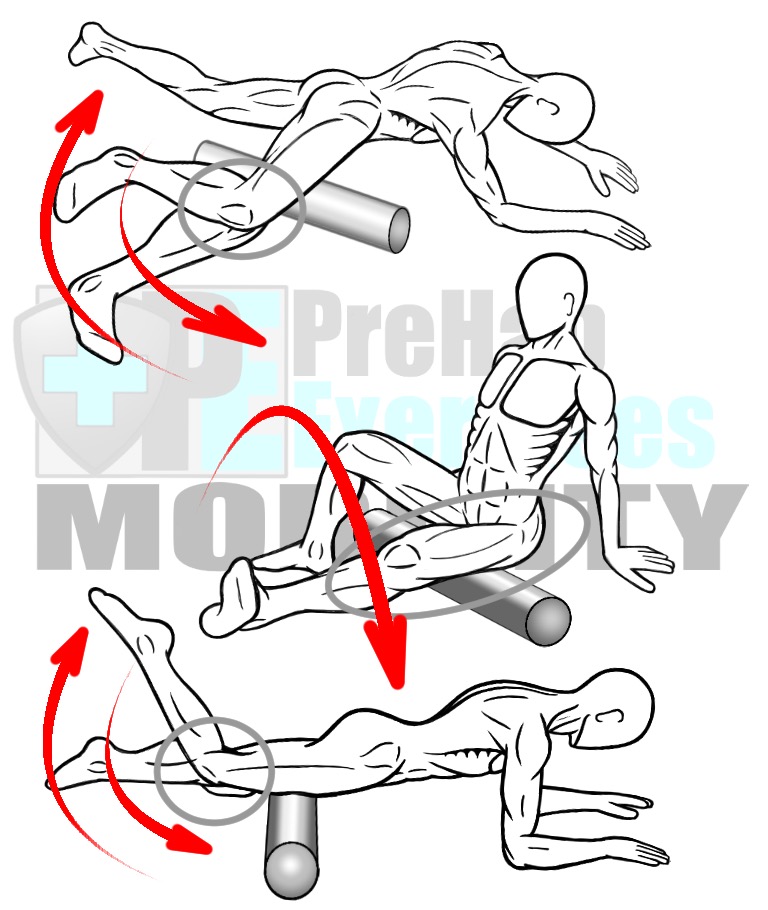
FOAM ROLLING THE ADDUCTORS (GROIN) WITH JOINT ARTICULATION
FOAM ROLLING THE BICEPS FEMORIS (LATERAL HAMSTRING)
FOAM ROLLING THE QUADRICEPSWITH JOINT ARTICULATION
GROIN AND LEG WITH VARIOUS TECHNIQUES
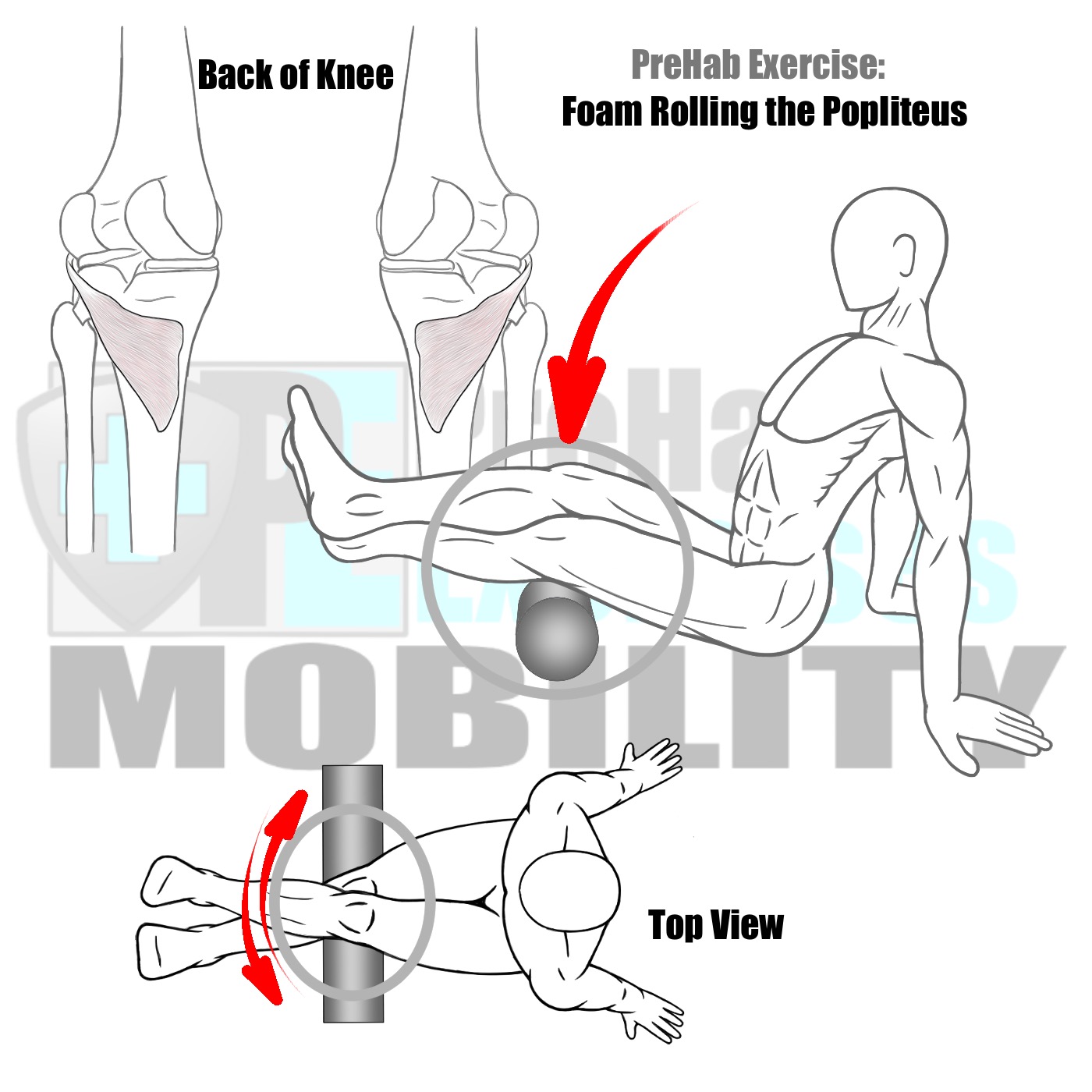
FOAM ROLLING THE POPLITEUS
POSTERIOR KNEE
Benefits:
• Improve the arthrokinematics (joint function) of the Knee and helps to prevent Valgus Knee Movement, Pronation Distortion Syndrome and ACL injuries.
• Improves Movement Quality in Squatting, Hinging, Lunging, Jumping, Running and Standing.
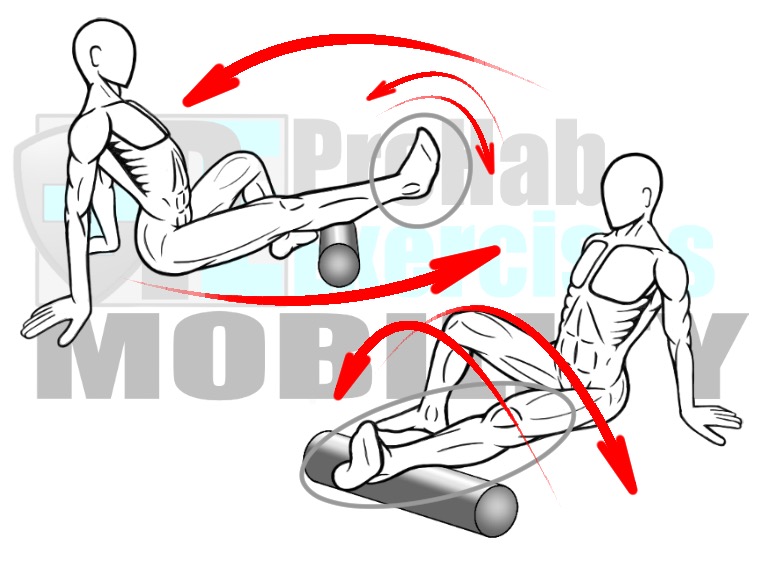
FOAM ROLLING THE GASTROCNEMIUS AND SOLEUS WITH OSCILLATIONS AND JOINT ARTICULATION
CALF
Benefits:
• Increases the Range of Motion of Ankle, Knee and Gait Cycle.
• Improves force transfer and coordination from the Hip through the Ankle/Foot and into the Ground, which translates to increased Movement Quality in Squatting, Hinging, Lunging, Jumping, Running, and Standing.
• Helps to correct Glute Amnesia Syndrome, Sway Back, Asymmetrical Weight-Shifts, and improves static posture and dynamic alignment.
• Promotes post-exercises, soft tissue recovery, and regeneration.
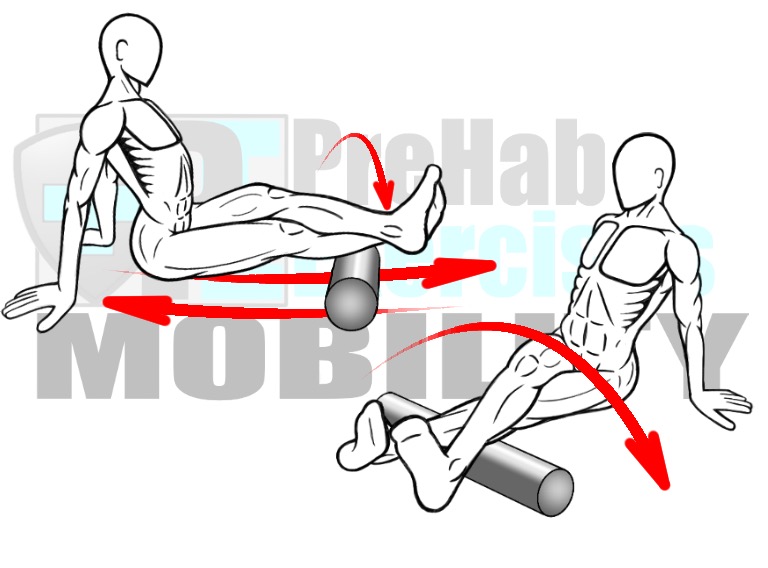
FOAM ROLLING THE PERONEALS
LATERAL CALF
Benefits:
• Increases the Range of Motion of Ankle, Knee and Gait Cycle.
• Improves force transfer and coordination from the Hip through the Ankle/Foot and into the Ground, which translates to increased Movement Quality in Squatting, Hinging, Lunging, Jumping, Running, and Standing.
• Helps to correct Pronation Distortion Syndrome, Glute Amnesia Syndrome, Sway Back, Asymmetrical Weight-Shifts, and improves static posture and dynamic alignment.
• Promotes post-exercises soft tissue recovery and regeneration.
PreHab Exercises – Improving Movement
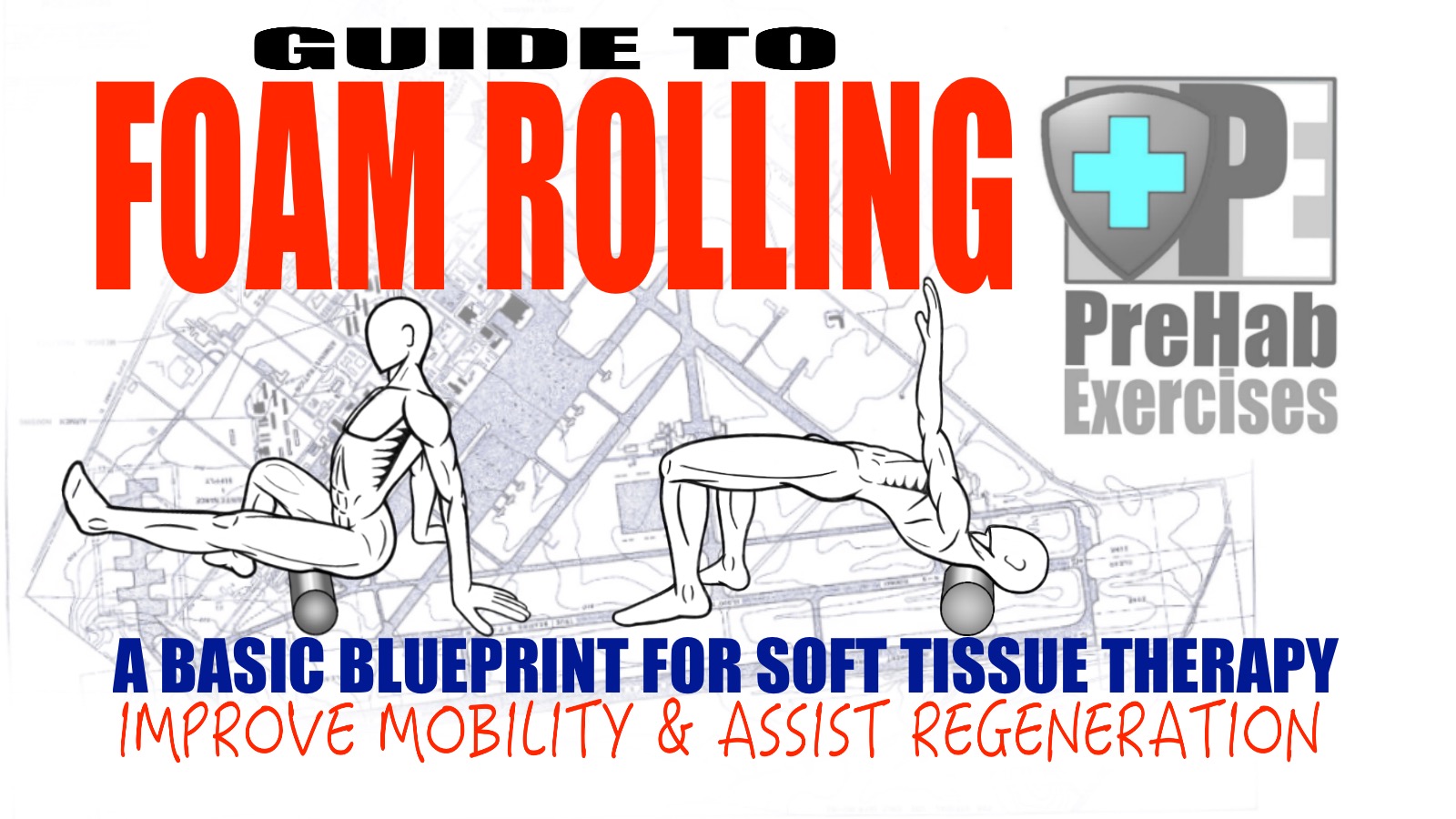
2 thoughts on “Guide to Foam Rolling – A Basic Blueprint for Soft Tissue Therapy”
Comments are closed.